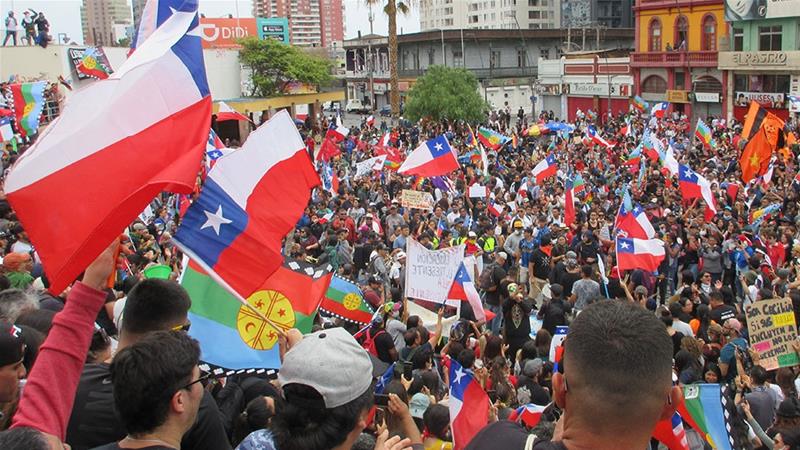An In-Depth Look at the Chilean Protests
November 16, 2019
by Angela Gil, Staff Writer
At least 20 civilians have died in the Chilean student demonstrations that began in early October. Their initial cause was a 3% hike in Metro fares, and they highlighted key issues within the Chilean government such as low wages, a flawed public health system, and drastic socioeconomic inequality. Now, after seeing the government’s reaction to the first peaceful protests, the demonstrators are calling for constitutional reform and for current president Sebastian Piñera’s resignation.
When the Metro fare was raised, the Minister of Economy at the time suggested that people wake up earlier to get discounted prices on public transport. This led to the first protest, which consisted of mass fare evasion; people would leap over and, in some cases, break the turnstiles leading to subway stations. This soon spiraled into more violent demonstrations when the police responded to the fare evasion with force.
In response to the aggression, Piñera declared a state of emergency, so he could further limit the freedoms of his citizens. His justification for this preemptive declaration was that he wanted to prevent crime, Piñera went so far as to say that he was “at war” with his own people. Izzy Martinez ‘20 reacted that, “He literally called the people of the country the enemy. How is it possible to call your own people the enemy? . . . They want him to resign, but he says, ‘No, I was elected through a democratic process, so I’m not going to leave office.’”
On the 27th of October, the Chilean president lifted the state of emergency due to public outrage and replaced eight of his cabinet members that had called the protesters criminals, including the aforementioned Minister of Economy.
Although, at less than 0.05 USD, the thirty pesos increase may not seem like much, it made the subway unaffordable for people working at minimum wage. The minimum wage in Chile puts 60% of the population below the poverty line. Chile’s current constitution was established during the Pinochet dictatorship, and the people want to change it. Pinochet’s reign in the 1980s resulted in the “disappearance” of over three-thousand people, and the exile of hundreds of thousands. In late 2017, Piñera was elected with 54.47% of the vote. Now, he has a 14% approval rating, which is the lowest since Pinochet’s military rule.
On the portrayal of the demonstrators in the media, junior Sebastian Valenzuela commented, “I think the media prioritizes violent stories and reports on unrest and rioting as opposed to peaceful demonstrations and genuine calls for change.” Lauren Valentin, a sophomore, agreed. “The media right now is portraying it as a very violent thing. Which, it is true, there are a lot of violent or destructive ways people are protesting, but at the same time there are also many people that are just silently protesting or coming together and voicing their opinions without being so aggressive,” she said.
So, what can Latin students do? With international issues, it can feel difficult to contribute or even voice an opinion effectively. Sophomore Lily Ruiz offered some advice. “Somewhere we could start is getting people aware of what’s going on,” she said. Students in Chile have taken to social media to spread the word and ask for help. “By word of mouth,” Lily continued, “people can become aware and hopefully start to advocate for the protests.” The internet, especially social media, remains unaffected by distance and national boundaries.



























































Robert Igbokwe • Nov 17, 2019 at 10:00 pm
Fantastic article, Angela!! I didn’t know much about the protests before reading and you did a wonderful job covering it and the school’s opinions on it. Thank you for sharing with us and I hope we can all follow your advice! 🙂 🙂